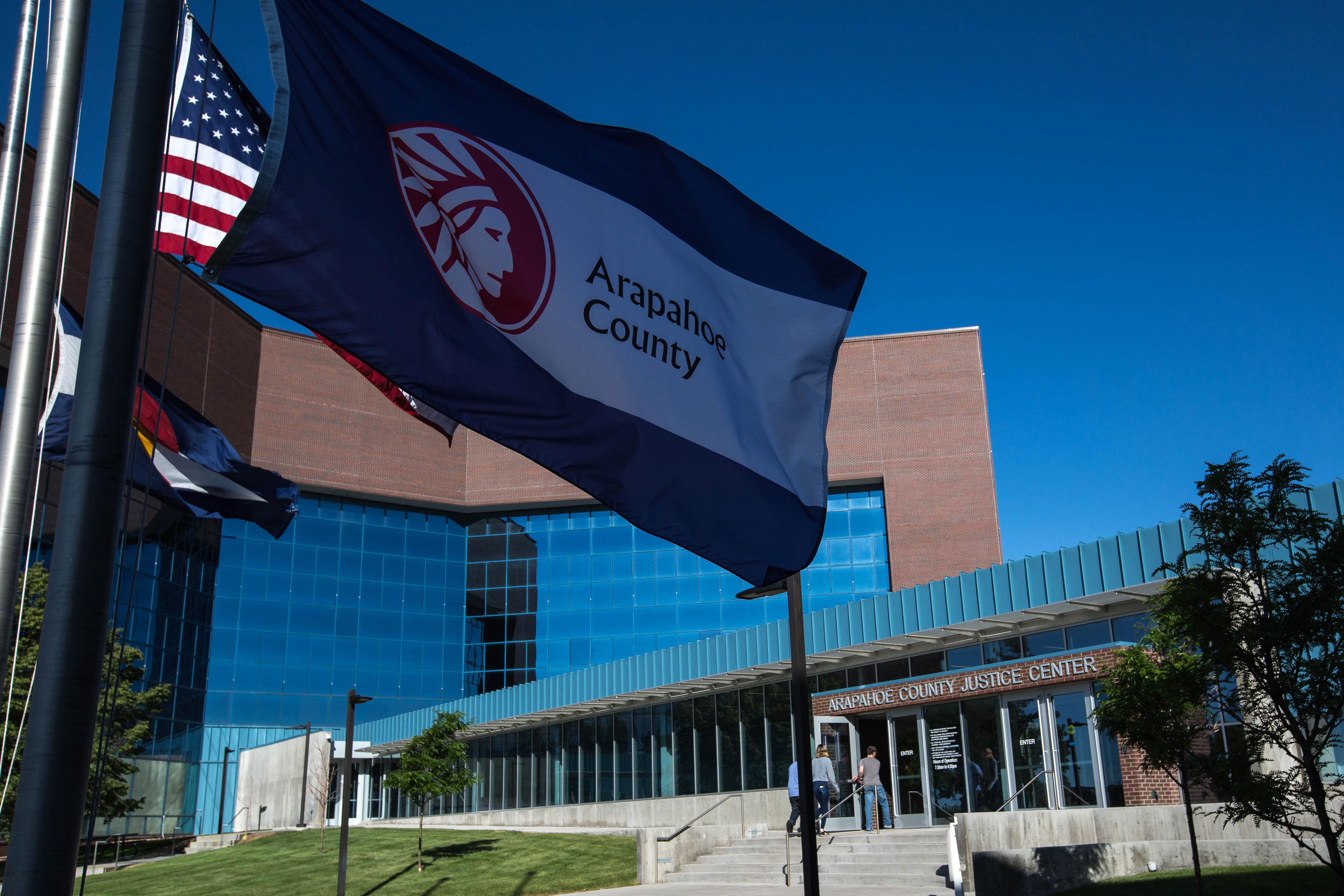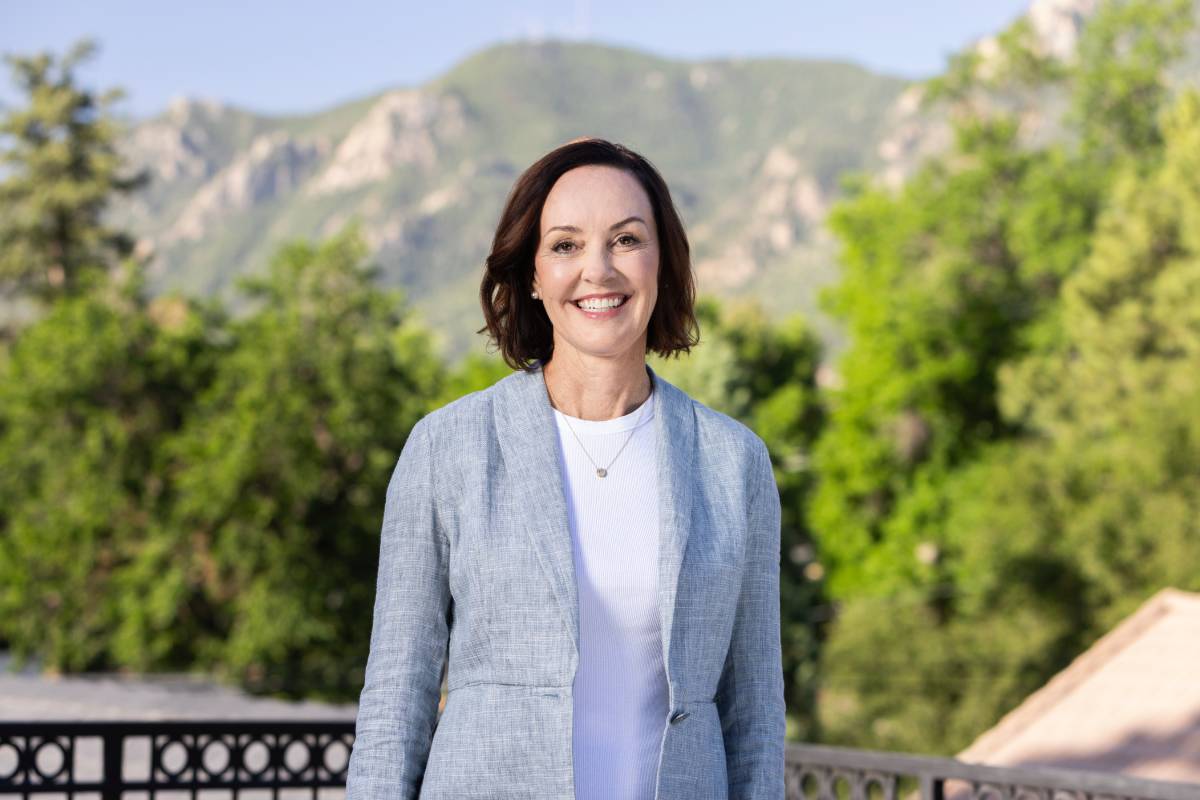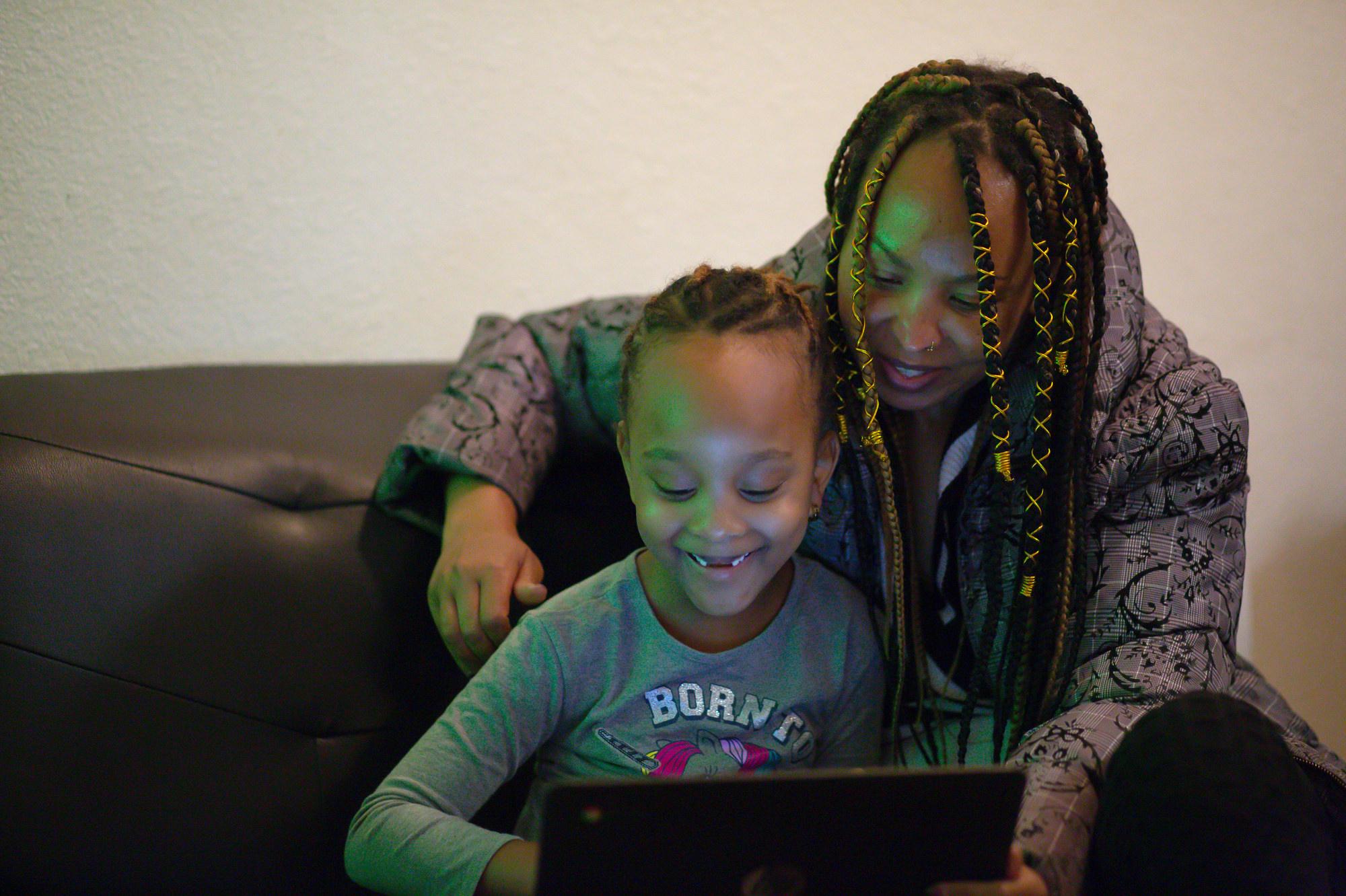
When Khan Mwezi landed in Colorado eight years ago from a refugee camp in Uganda, she arrived with a high-risk pregnancy.
Her daughter, Martinode Hill Gift, was born prematurely and stayed in the neonatal intensive care unit for four months. During that time, Mwezi spent a lot of time with infants. As her husband scraped together a living for them, Mwezi attended to all her daughter’s special needs.
“Life was very, very difficult,” said Mwezi, who had no family support because most of her family was killed in wars and ethnic strife in the Congo.
Little did Mwezi know that seven years later she’d be back caring for infants, and filling a critical workforce need in Colorado. She’d landed a part-time job at an early child care center. The state’s early childhood worker shortage is most acute in infant and toddler care, with about half as many workers currently employed as are needed.
As an assistant teacher, Mwezi makes $14.77 an hour but she’s not stopping there. After she comes home from work and checks in on her eldest daughter and Martinode, now a healthy six-year-old, Mwezi hits the books in the family’s Aurora apartment. She is studying brain development, behavior management and cognitive development in children.
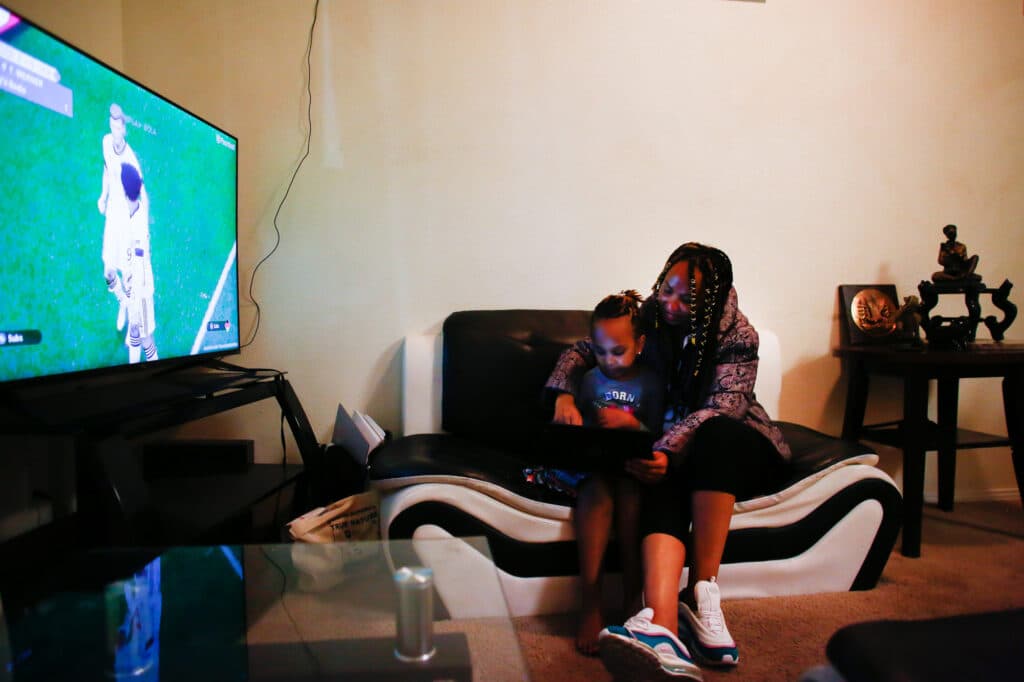
She’s enrolled in the Pamoja Early Childhood Education Workforce Program, a pilot program to increase the number of early childhood educators who are fluent in multiple languages and who can meet Colorado’s growing need for diverse educators serving young children living in poverty, dual-language learners and children with special needs.
One Colorado study shows half of the state’s teachers work in classrooms where they didn’t speak the primary language of the children in their classrooms. The more educators who reflect the demographics of their students, the stronger the impact on children’s optimal development, according to Colorado’s 2020 Early Childhood Workforce report, which lists a more diverse workforce as a goal.
Khan Mwezi, who speaks Swahili and is learning English learned about the Pamoja child care classes through someone in Denver’s African community.
“It was very difficult to go through that application but when I finished, ‘Boom!” Mwezi clapped and smiled. “They called me.”
She said she has always loved children and thought it would be a better job than the cleaning job she held for several years before a car accident left her in need of physical therapy.
“I say, ‘Let me try this.’ I was feeling I can be successful, I can get very far.”
Lead teachers and center directors are disproportionately white in Colorado, with more women of color working as assistants. Many hope programs like Pamoja will change that.
“This is a potential bright spot because we have a lot of people in the classroom who like what they're doing,” said Jennifer Stedron, executive director of Early Milestones Colorado, a statewide early childhood nonprofit. “And if there's support, they can have some more training and go on to be lead teachers.”
Early Milestones Colorado, which, along with the Buell Foundation and Gary Community Investments, provided a grant for the Pamoja pilot, studied the barriers to entering the early childhood workforce, particularly for women of color. A big barrier for immigrant and refugee women is a lack of money, time and the English skills to attain a traditional post-secondary education. Enter big, innovative, out-of-the-box ideas.
From Mortars To Education
Deborah Young has worked all over the world, in refugee camps and in crisis zones with bombs flying overhead.
The one constant is there are always children who need care. Her organization, Empowering Communities Globally, works to strengthen the capacity of women and organizations that serve infants, children and families. It uses a five-step empowerment process to reduce the impact of poverty through participation and education.
Young thought, why not use a similar model to help refugee and immigrant women become a piece of the solution to Colorado’s early childhood workforce shortage?
“It aligns culturally, it aligns religiously, it aligns with their family values,” Young said.
She teamed up with Lauren Dorn, with Lutheran Family Services Rocky Mountains, who has more than a decade of experience working with immigrant and refugee families.
The organizers say they see in the women a resounding love of being a mother and a desire to understand how to be a better mother.
“So, why would we not bring them into the field of early childhood education?” Dorn said.
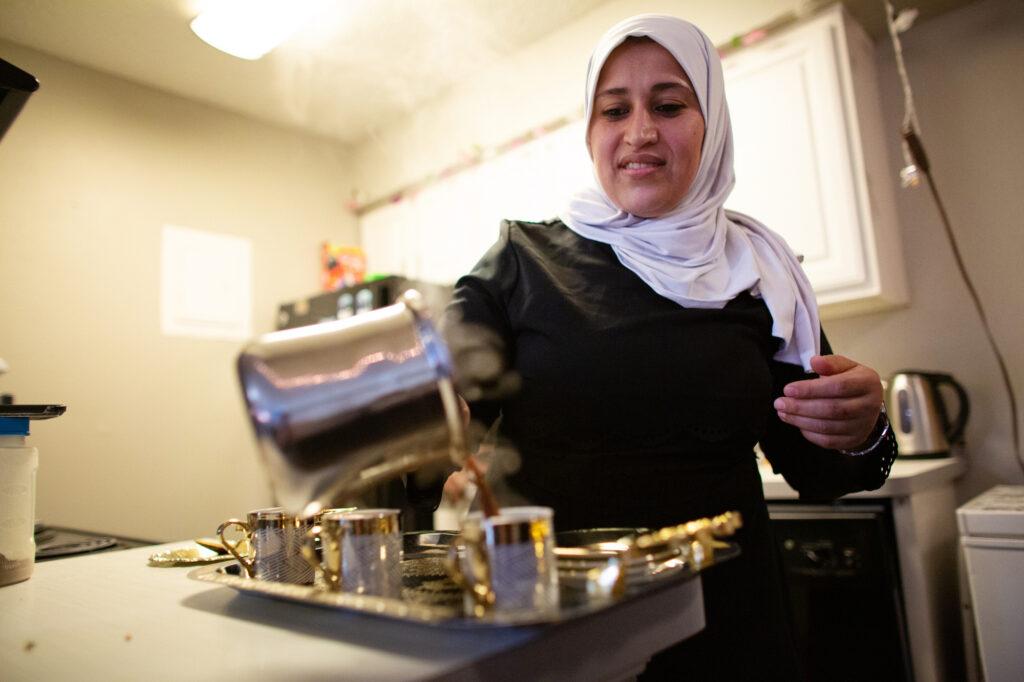
The Pamoja program trains cohorts of women in early childhood education in four languages: Swahili, Arabic, Farsi and Karen, which is spoken by refugees from Burma and Thailand. The demand for the classes, even during the pandemic, has been overwhelming.
“It’s been crazy and we keep getting more people, but we did finally have to communicate like, ‘We're so sorry ... there’s a waiting list.’” said Dorn. “We keep getting emails from community members that are working with refugee communities saying ‘We heard about your program. Can you tell us more? We have women who are interested.’”
The 55 women in the current cohort are training to take a test for an 18-week national credential called the Child Development Associate through Mile High Early Learning. Some already work in child care centers as aides or assistants. If they meet volunteer requirements, pass the CDA exam and observation, they are certified to teach in classrooms.
“This will give them more job security and a higher pay scale,” Dorn said. The women also have one intensive English class per week taught by the Spring Institute, and they meet with a mentor one-on-one to make sure they have the proper support to finish their certificate.
State scholarships pay for the CDA courses and the federal Workforce Innovation and Opportunity Act pays for some women to enroll in a pre-apprenticeship program in early childhood education at Red Rocks Community College. A host of other nonprofits like Boomers Leading Change, paired older adults with women to be mentors for homework and technology skills while building relationships.
A Calling
The adhan, the Islamic call to prayer, goes off on Sabah Almobarak’s phone, wafting through the kitchen to the back of her southwest Denver apartment.
Almobarak and her husband have seven children in all, one with special needs. In her spare time, she’s found a new passion: studying to be an early childhood educator.
“I love children a lot,” she said in Arabic, after serving a visitor fresh home-baked desserts and tea. “I love children, and I want to take care of them.”
Almobarak’s family moved to the United States in 2017 to escape Syria’s civil war. She tried community college classes, but her English wasn’t good enough to keep at it. On an Arabic Facebook group, she heard about the Pamoja program.
“That’s when I got motivated because it’s all in Arabic and the classes, all the content, everything will be in Arabic so I’ll understand it better,” Almobarak said through a translator.
In a recent Zoom class, Almobarak learned about physical and cognitive development in children, including concepts like maturation, the rate of change and perceptual and spatial awareness. The class flowed back and forth between Arabic and English with the aid of Soad Altaai, an interpreter and cultural coordinator.
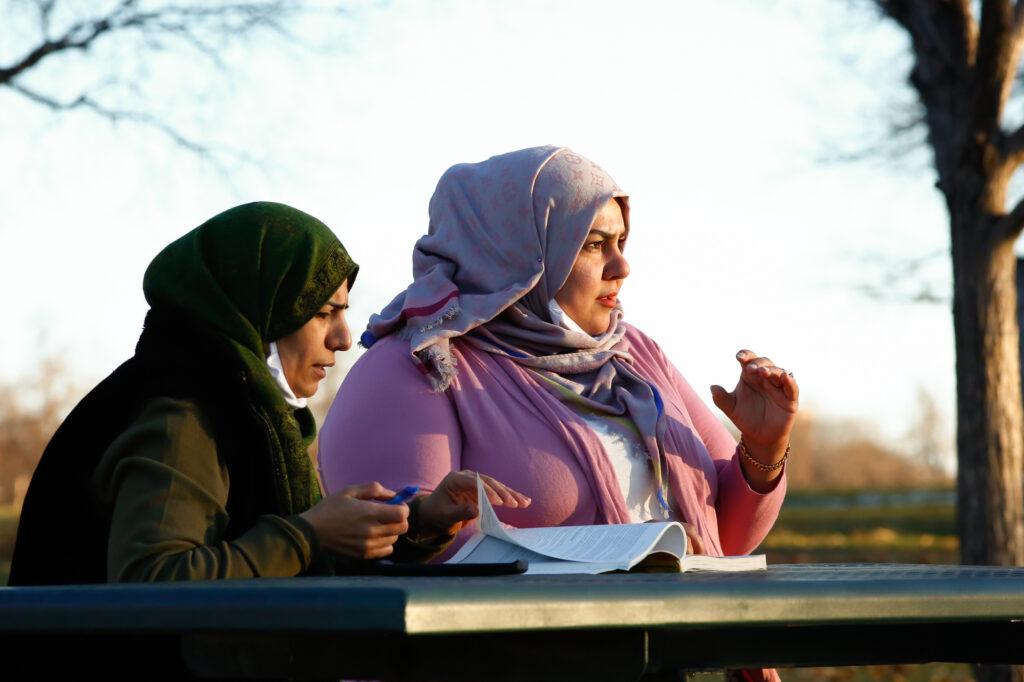
Trainer Stacy Lutz-Ovies asked the women for examples of what the brain needs to develop connections. The women said healthy food, adequate sleep, love, respect and positive relationships.
“Is it true that routine will build good brain connections?” one woman asked.
“A routine creates a predictable environment and we know that children feel safer when their environment is predictable and therefore they build healthy connections,” Lutz-Ovies told them.
Another woman is curious about how puzzles in particular help with brain development. Her husband, off in the background, wants to know as well.
Lutz-Ovies tells them because puzzles require matching shapes, they help with literacy development, fine motor development, spatial awareness and cognitive development. But there is one thing a puzzle doesn’t do.
“We also need material available for children that are open-ended meaning there is not a right answer,” Lutz-Ovies said, describing Legos — the block toy — where children can make anything from cars to dragons. “We also have to have those types of activities that allow children to have creative options where the problem solving is ‘What do I want to make and how do I make that?’”
Lutz-Ovies steers the women back to her lesson on infant motor development, like the Babinski reflex.
“Yes, I’ve raised seven kids,” Sabah Almobarak marveled. “But I didn’t know how children’s brains develop, how the brain functions. I understand more now about how children behave and act. What I’m learning is really fascinating.”
Requirements And Hurdles
Huda Jasim is particularly keen to learn about teaching children with disabilities or behavioral issues.
“I’ve never dealt with an exceptional child, someone with disability,” said Jasim, who came to the U.S. from Iraq eight years ago. “This is something that I really want to learn. I prefer to get more education and get all the tools to be able to volunteer.”
The CDA credential requires 120 hours of instruction, 440 work or volunteer hours in an early childhood program, a portfolio in English and an observation by a specialist.
Jasim tried to attend Red Rocks Community College but couldn’t qualify for financial aid because she couldn’t produce her high school diploma from Iraq. The Pamoja program was a perfect fit. Once she has her credential, she’d like to work in a child care center before maybe one day running her own child care business.
“I really want to support my family,” she said. “My husband works, but by himself, we cannot make a living. I have three kids and, in the future, they want to attend university. My daughter is very interested in the medical field. My son wants to be a scientist, so all that needs money. So, I’m trying. I’m taking classes. I’ll get a job so in the future. I will support my family.”
The Pamoja program offers support like how to use computer programs like Google Docs and Zoom. It helps families with basic needs like providing food boxes and diapers, and it connects other family members to jobs. Most of the women in the program didn’t have computers until recently.
“If you could imagine doing your homework and writing a two-page paper on your phone?” Young said.
The program also tries to tap into women’s strengths. Can they become coaches? Can they become consultants? What are leadership opportunities for them?
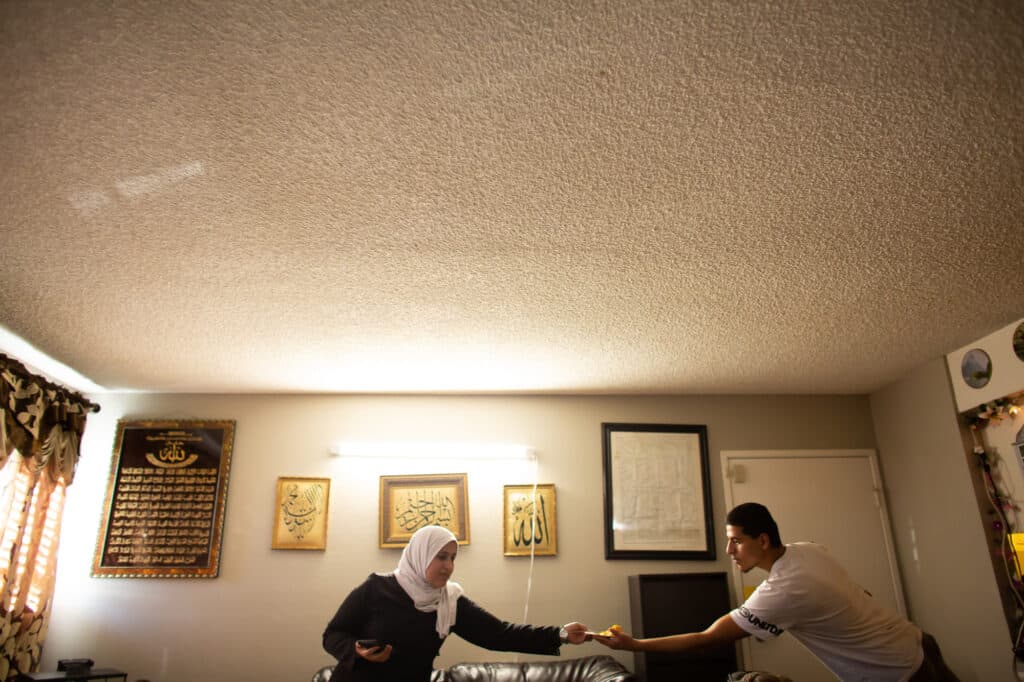
One lesson learned by the organizers is even though they use interpreters, the program still requires a certain level of English proficiency.
“Some of the women have dropped out because of the English proficiency,” Young said. “That's devastating. This isn’t about knowing English. This is about child care.”
Much of the course focuses on reading and writing, but most of the job of an early child care worker is talking, Young said. She worries the bar is set too high for a job that pays $13 an hour. To have a truly diverse workforce, she said the state must try to build on the skills and abilities the women have.
“Should you have to write a five-page paper in English to be able to be an early childhood teacher? Or should you be able to understand the nuances of different families and be able to greet them where the family is at? Which is more important? It’s supposed to be about content. It's not supposed to be about English.”
Many of the women said they are nervous about taking their CDA exams. It can be taken in English or Spanish, but so far, the test is not offered in other languages — something organizers want to change.
“We're trying to learn and navigate and advocate for better systems that meet the diverse workforce and passing these tests and standards that are very much centered around native English speakers,” Dorn said.
Overcoming Cultural Differences
There is also a cultural hurdle in helping women find jobs. Some providers lack a willingness to hire someone with limited English capabilities, not realizing that their language skills will likely grow on the job and that these women often have cultural and life skills to better relate to families and children.
Another challenge is finding early childhood trainers who understand that teaching women from around the world isn’t just teaching pieces of information, Young said, but that they must take their “lived experience and compare it to what is expected in the U.S.”
There are all sorts of cultural nuances and “hidden agendas” the women need to learn. For example, “taking initiative” is praised in the U.S., especially in the workplace. But it’s not that way in other places.
“If you're coming from a conflict area and you take initiative, you are being visible. You are in harm’s way,” Young said. “When you are in a conflict area, you want to blend in and become part of a wall because that's safe.”
Khan Mwezi, the infant educator from the Congo, said understanding and navigating all the cultural differences in a new work environment can be challenging. It can be small things: In the first month of her new job, she got two parking tickets until her employer told her about a street where she could park for free.
In another instance, Mwezi got confused because one co-worker from another room prepared the babies for their nap one way but Mwezi, based on the latest research, was taught another way.
“I was thinking, ‘They have more experience, they know what they are doing, so I don’t need to say anything.”
There were a couple of other incidents, including one where an assistant told her she didn’t need to use gloves to clean. This left Mwezi stressed out, unsure of when she should notify her supervisor after being asked to do something improperly.
“I feel like I want to cry. I cover my face because my tears are going [to] come down. I didn’t say anything.”
Her lead teacher had witnessed some of the interactions and advised Mwezi to tell the assistant that she would use gloves, “and if there is something you don’t understand you just ask me.”
Mwezi does love her job. She knows as her English improves, so will her confidence.
“I like my job because I’m with the infants …. so cute when you’re playing with them and they’re happy. When I leave, they cry. It makes me feel too much love.”
This story is part of a series produced as part of the Higher Education Media Fellowship at the Institute for Citizens & Scholars. The Fellowship supports new reporting into issues related to postsecondary career and technical education.
Photos by Kevin Mohatt for CPR News.
Correction, 1/12/2021: Classes at Pamoja are taught in Farsi as well as three other non-English languages. An earlier version of this story incorrectly identified the language.



